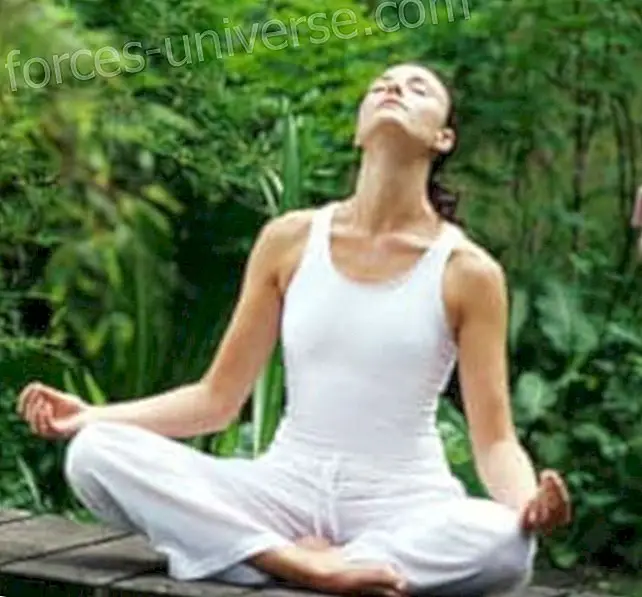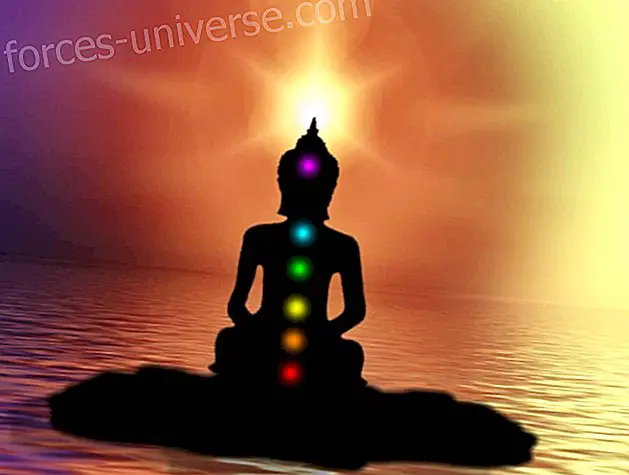 Meditation, in a group or alone?
Meditation, in a group or alone?
Meditation, especially at the beginning, is an exercise in patience, constancy; For this reason, it is convenient to practice in a group and, preferably, with someone who corrects the posture and sets the guidelines to follow. Once the technique is learned (if there is any technique), accustomed to the posture and fixed the routine, you can try meditation alone.
In any case, group practice reinforces the routine and avoids discouragement. On the contrary, meditating alone can lead to a more authentic practice, although it is more difficult to persevere. It may be a good idea to combine the two methods: practice only regularly, and go to group retreats or, in isolation, to a Meditation Center.
Meditation is, observe without judging.
Is a teacher necessary?
Meditation is "contemplation." In this sense, great or complicated knowledge would not be necessary to learn in order to meditate, and the role of the Master could be considered as that of a mere instructor who provides us with a concrete technique.
 However, the Meditation Master is much more than an instructor since he himself must master this science and have a psychological acuity that only practice provides.
However, the Meditation Master is much more than an instructor since he himself must master this science and have a psychological acuity that only practice provides.
The Master is basic at the beginning and recommended later to correct and guide the disciple along the subtle path of meditation. Finally, we must not forget that the best Master we carry within.
How many types of meditation are there?
In a very general way, meditation can be included in two types: with an object and without an object of concentration.
* Meditation with object is the most widespread and consists in concentrating the thought in said single object, excluding any thoughts that distract attention. The object can be something physical, tangible, like a point of the body, the sun, the moon, a flower, a landscape, a mantra, etc; and it can also be something more subtle, like a chakra, a sensation, a philosophical thought, a koan (deep phrase, without logical sense, typical of Zen), etc. With this type of meditation it is sought to exclude any thought, except the one referred to the object of concentration to, finally, also transcend said object. * Meditation without an object (typical of Yoga in its most advanced phase) consists in moving away from all objects, from all thoughts, from all sensations and experiencing “decentralization”, becoming a pure observer.
Why meditate?
The practice of meditation arises to try to find an answer to the big questions that are raised in relation to our deepest nature: who is not who I am? Where do I come from and where do I go? Why do I exist? What is my mission here?
In addition to seeking logical answers in science and philosophy, or of faith in religion, with meditation it is intended to transcend the ordinary state of consciousness and transfer, from some In a way, ordinary reality, waking up to another vision of the things that fills us, and gives meaning to our existence.
Paradoxically, meditation should be practiced without a specific objective, without waiting for a particular achievement, not even the highest.
Why do you insist so much on having your back straight during meditation? Almost all meditation schools insist on keeping their backs straight as the basis of the best posture to adopt for practice. With a straight and vertical back, perfectly aligned, the attention is still more easily awake and immobility; In addition, the fundamental energy in the body circulates more freely.
Is it necessary to sit cross-legged? It is convenient, although not essential. Meditation that comes from the East is traditionally practiced with crossed legs. In this way, the back is held straight without effort and the posture can be maintained for a long time.
In any case, with the legs crossed, the knees must be lower than the pelvis so that it swings forward and the back can remain straight in balance on the sacrum. The use of a cushion under the buttocks is highly recommended for beginners who do not have the flexibility to make lotus.
What is the best time to meditate?
Any time is good to meditate although the most favorable moments are dawn and dusk, because in these hours the frenetic rhythm of ordinary life is relaxed. Are rituals necessary in meditation? Depending on the schools, the ritual becomes more or less important. When meditation is associated with a religion (Buddhism, Hinduism) the ritual is very important, using the symbolism and attractiveness hidden therein to t captivate practitioners. The ritual is still an object of concentration and as such can be used, although in a deep practice is not necessary at all. On the other hand, it is very difficult not to perform any kind of ritual, even if it is just a simple greeting.
Effects of regular meditation. In the purely physical aspect, meditation has relaxing effects, fighting hypertension and stress. Psychologically, it provides self-confidence, confidence, mental strength, concentration and memory. But its most important effects are on a spiritual level ...
Importance of hands during meditation. The hands, considered as an extension of our brain, serve to reinforce expression and show mood. Your position during meditation is very important; a symmetrical and symbolic position must be sought through a mudra. The most important mudras in meditation are:
* Mudra of wisdom, with the hands on the knees, palms up and fingers extended, except thumb and forefinger that rub their buds to form a circle. * Mudra of the void or cosmic, forming an oval with the palms one on top of the other and the thumbs touching their tips. * Mudra of respect or greeting, with palms together at chest height (this mudra is not usually maintained during meditation, serving only to start and finish it).
You can also keep your hands simply above your knees or in your lap with your palms facing up, one on top of the other.
Should the eyes be closed or open?
It also depends on the school. In Yoga they are usually kept closed and in Buddhism enclosed. In the types of meditation in which an object of visible concentration is used, they must obviously be open. In any case, the look must be lost in the infinite.
Is it convenient to burn incense during meditation?
During meditation it is intended to inhibit thoughts and all kinds of sensations, abstracting from them. With the incense an atmosphere is created that controls our olfactory sensations leading them to a regularity, to a rhythm, to which we get accustomed thus favoring mental abstraction.
How long do you have to practice?
Starting from the basis of regularity in practice, its time will be progressively increased and can range between 10 minutes and 1 or 2 hours (or more) for each session. The progression in the practice time should be very slow but constant, since it is easy to yield to boredom, lack of concentration, reluctance, mental dispersion, etc.
Generally, after half an hour or 45 minutes, the practice becomes easier and “special” (although at the beginning the legs may also hurt more).
"Electronic meditation" is meditation? No, as traditionally understood. The “New Age” meditation, with electronic inductors, colored glasses and relaxing sounds, can be a good relaxation system and be an experience that may lead to traditional meditation. But in no way can one say that in meditation there are “shortcuts” that are worthwhile. It would be important that you stay away from everything artificial if you don't want to run out of neurons.
What is said in the Yoga Sutras of Patañjali about meditation?
Dharana, concentration, is to fix consciousness on one point.
Dhyana, meditation, is a regular and continuous flow of attention directed towards the same point.
When the object of meditation absorbs the meditator, appearing as the subject, one's consciousness is lost. That is samadhi.
Meditation is the continuity of a stream of similar ideas, not disturbed by any other. While in concentration there is a disturbance with other ideas, this is not the case with meditation, since there is only one flow on the same idea. The prolonged and deep concentration leads to the state of meditative absorption (samadhi), in which the object is kept in the mind and fills the entire space of consciousness. All the ideas that appear revolve around the object of concentration and are accompanied by an emotional disposition that can be described as "serenity, " "peace, " or "calm." There is no loss of lucidity, but rather, the sense of alert seems to intensify. Obstacles to meditation Any change that is intended to be carried involves a natural resistance to such change. In this sense, the practice of meditation meets different obstacles that can lead to failure. The most important potential threats are the ten listed below:
Doubt.
It is the biggest obstacle in the path of Yoga. You can doubt from the correct execution and the effectiveness of the meditation, even from oneself. You can question, for example,
1. if meditation is too difficult for oneself (it is not!); 2. If you will end up hypnotized (of course not!); 3. if it is a form of escapism (no!); 4. if you have to give up everyday pleasures to be able to meditate (of course not!); 5. if it can clash with one's religious beliefs (at all!); 6. if it is necessary to have a teacher (it is not essential!).
Everyone is perfectly capable of meditating. But do not expect wonderful results at the beginning. Tips:
1. Write down on a paper all the doubts that arise about Yoga and meditation and then analyze them one by one. It will be discovered that after a detailed analysis, many of the doubts are unfounded and some even ridiculous. 2. If after this exercise, you still have serious doubts that prevent you from practicing meditation, you have to find a competent instructor to help clarify these reservations.
Boredom.
Meditation (which consists in doing nothing, rather than paying attention) quickly leads to boredom for the superactive mind, which immediately uses different solutions that free it from boredom. Accept boredom and, at least temporarily, make it the center of attention.
Dream.
Many beginners succumb to sleep because unconsciously it is associated with a slowdown of mental processes during meditation. Tips:
1. Check that the posture is correct. 2. Keep your eyes more open. 3. If necessary, get up and practice walking meditation (or one or two appropriate stretching asanas) for a few minutes, before sitting down again.
Physical discomfort
Often, from the moment the posture is adopted, body awareness is magnified by the slightest bodily sensation. Even an insignificant itching can be the biggest drawback. Feel the itching, breathe through it and continue with the meditation. In fact, the itching sensation can provide additional energy to concentrate better. If the feeling escapes control, simply scratch! Do not make a mountain of a grain of sand.
Negative thoughts.
Meditation can uncover the negative tendencies that reside in the subconscious. Facing face to face with our negativity can be really annoying. Tips:
1. Do not consciously retain negative thoughts or feelings that may arise. 2. Remember that one is not just the feelings and thoughts that arise. 3. Choose to cultivate the exact opposite of any negative thoughts or feelings that appear on the mental screen. For example, if dark thoughts of resentment about someone suddenly appear, you just have to raise thoughts of love and friendship by projecting them to everything around us.
Rush.
Nothing is more dangerous in the way of Yoga than running to see what happens. Certainly, you cannot hurry in meditation. Cultivate patience. Give the body and the mind enough time to change. Do not force anything at all.
Santurronería.
In Zen, those who enter this state of purported holiness are colloquially told to "stink of Zen." Unfortunately, this state does not only occur in Zen; characters of this type can be found in all spiritual and mystical systems. Such "enlightened" proclaim to others that they experience a powerful meditation and that they possess true knowledge. In their view, they are a kind of teacher. This beginner's error hides, behind that mask of false appearance, a great inferiority complex. The true teacher never talks about achievements. Tips:
1. Be realistic, modest and humble about the first achievements. 2. It is normal to rejoice in natural progress along the way, but you should not be proclaimed. 3. If the inner progress is correct, the others will notice it sooner or later, but the most important thing is that it is you who feel the changes, in the true evolution the others do not matter.
Ghostbusters
Some beginners see meditation as if it were a hunt for paranormal powers. They expect all kinds of experiences, flashing lights, spectacular visions, extraordinary sounds, etc. When such special effects do not appear, novice practitioners become disillusioned with meditation and often fall into fantasy. You must understand the purpose and nature of meditation, which is to accustom the mind to the sensation of peace and recollection, in order to facilitate inner growth. It's that simple.
Illusionism
Be careful with the attitude that suggests that nothing really matters because basically everything is illusory. Meditation shows exactly how much of our ordinary reality is built by the mind, but that does not mean that anything is important. Often this attitude has to do with lack of maturity. Tips:
1. Understand that Yoga applies to all aspects of life. 2. Continue with work, with attention to family and friends. 3. Be responsible and aware of the benefits of the practice of Yoga.
Symptoms of Kundalini
The symptoms of the awakening of kundalini have recently become more popular among meditators after the publication of certain books on the subject. These symptoms include psychosomatic phenomena such as energy currents through the body, tremors in the limbs, involuntary body movements, hallucinations, etc. Actually, the symptoms of a true awakening of the kundalini are very rare. Most of the cases registered are only symptoms of mental illness, pure imagination, or simple precursors of arousal of the kundalini. Tips:
1. If the symptoms are mild, they can be treated with an appropriate diet, natural lifestyle and alternative medical therapies such as homeopathy or acupuncture. 2. If the symptoms are more severe, it is advisable to seek an expert in phenomena caused by kundalini
Seen at: El-Amarna

 Meditation, in a group or alone?
Meditation, in a group or alone? 




